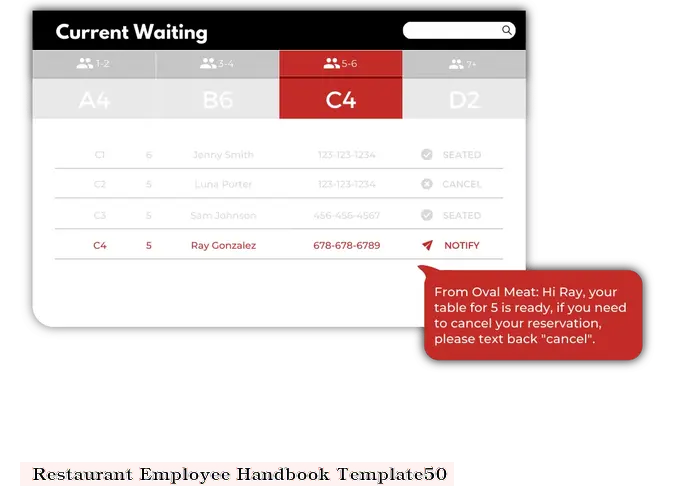

1. Introduction: In the introduction, provide an overview of the restaurant and its values. It should include the mission statement, company history, and the principles that guide the business. This section sets the tone for the rest of the handbook and helps employees understand the culture they're joining.
2. Employee Conduct and Expectations: In this section, outline the expected behavior and conduct for staff members. It may include dress code, punctuality, communication, conflict resolution, and any other critical aspects that contribute to a positive and productive work environment.
3.Job Descriptions and Responsibilities: Provide detailed job descriptions and responsibilities for each role within the restaurant. This section should outline the specific tasks and expectations for positions such as servers, bartenders, hosts, cooks, and management.
4. Training and Development: Emphasize the importance of training and development by outlining the restaurant's approach to employee development. This section may cover orientation processes, ongoing training programs, and opportunities for career advancement.
5. Workplace Safety and Health: In this vital section, address workplace safety and health protocols. It should cover topics such as crisis management, emergency procedures, first aid, and the proper use of equipment. Emphasize the importance of maintaining a clean and hazard-free work environment.
6. Point of Sale (POS) System: If your restaurant uses a POS system, dedicate a section to its proper use. Provide step-by-step instructions on how staff members should operate the system, trouble-shoot common issues, and address any specific policies regarding tips, discounts, and Void's.
7. Cash Handling Policies: Outline cash handling policies and procedures. Define the steps staff must follow when receiving payments, processing refunds, and handling voids. Establish clear guidelines for cash handling, such as counting and reconciliation procedures.
8. Food Safety and Sanitation: Emphasize the importance of food safety and sanitation. Provide guidelines for proper food handling, storage, and disposal. Include policies for cleaning and sanitizing and establish strict protocols for food safety to ensure a high level of quality.
9. Customer Service: Outline the restaurant's approach to customer service. Emphasize building positive relationships with customers and addressing customer complaints. Define procedures for taking orders, serving food, and ensuring an exceptional dining experience for customers.
10. Confidentiality and Data Protection: Discuss confidentiality and data protection. Emphasize the importance of staff members keeping customer and company information private and secure. Outline policies for handling sensitive information and the consequences of violating confidentiality agreements.
11. Social Media and Brand Representation: In this section, discuss the restaurant's expectations regarding social media and brand representation. Outline guidelines for staff members when discussing the restaurant online or in public forums.
12. Employee Benefits: Outline the benefits available to employees, such as health insurance, paid time off, and retirement plans. Include information about eligibility, enrollment, and any relevant deadlines.
13. Employee Evaluations and Performance Management: Define the restaurant's approach to evaluating employee performance. Outline the process for regular evaluations, setting performance goals, and addressing underperforming employees.
14. Termination and Separation: Cover termination and separation procedures. Outline the steps staff members must follow when leaving the company, including returning company property and equipment, and completing exit interviews.
15. Legal Compliance and Ethics: Provide information about legal compliance and ethics. Emphasize the restaurant's commitment to equal employment opportunities, harassment, and discrimination policies, and summarize local and national laws that apply to the workplace.
16. Glossary and FAQs: Finish the handbook with a glossary and FAQ section. Include definitions of industry-specific terms and answer common questions from new hires. This section can ease employees into their employment and help them navigate any unfamiliar terminology.
Remember that a restaurant employee handbook template should be customized to fit your establishment's unique needs and policies. After you've created a comprehensive handbook, take the time to review it with new hires, answer any questions they might have, and make sure everyone understands their responsibilities. Keep it updated regularly to reflect changes in policies and regulations. With a well-crafted employee handbook, you can build a cohesive team that can provide outstanding service and drive your restaurant's success.
DISCLAIMER: This information is provided for general informational purposes only, and publication does not constitute an endorsement. Kwick365 does not warrant the accuracy or completeness of any information, text, graphics, links, or other items contained within this content. Kwick365 does not guarantee you will achieve any specific results if you follow any advice herein. It may be advisable for you to consult with a professional such as a lawyer, accountant, or business advisor for advice specific to your situation.

today
Copyright © 2025 Kwick365.com
Designed by KwickPOS is the best restaurant POS